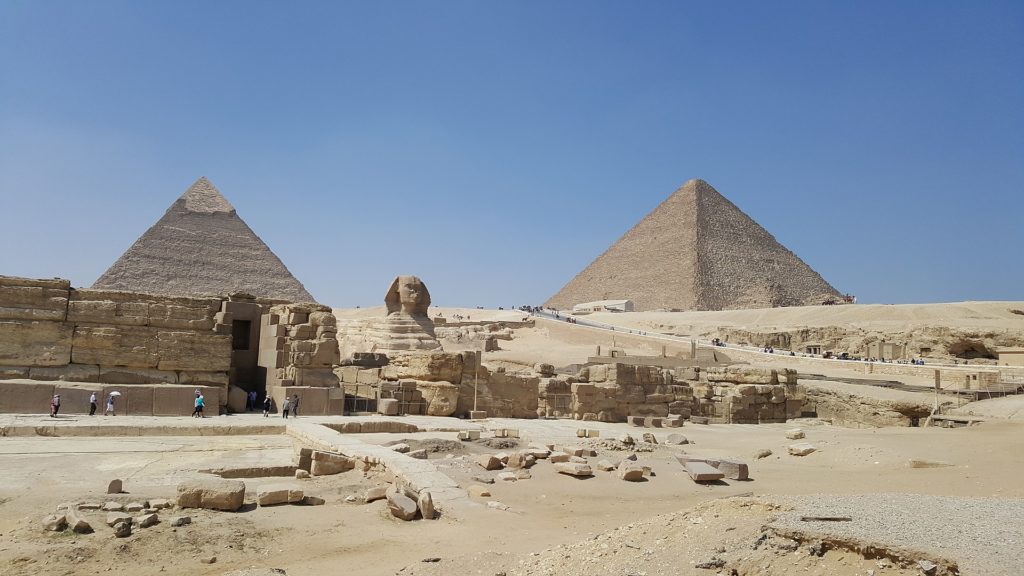
The construction of the Pyramids of Giza and the origin of the Sphinx in Egypt will forever remain mysteries as no scientist has ever produced convincing explanations of their making and the speed of completion.
The lack of solid answers to questions asked for centuries has led to countless theories about the origin of those amazing, massive structures their construction seems to defy logic and science, given the time they were built.
The theories range from alien constructors who landed on Earth and built the pyramids almost overnight to speculation that large groups of laborers worked for decades rolling, pulling, pushing, and lifting 2.3 million blocks of limestone and granite weighing 2.5-8 tons each, were paid decent wages, ate proper meals and slept in stone accommodations. And all that to build the Great Pyramid of Khufu alone, weighing a total of six million tons.
Yet, to explain the mystery of constructions of such magnitude built 4500 years ago in simplistic 21st century construction terms is as convincing as saying that one morning the Egyptians woke up and saw the three pyramids standing and the Sphinx smiling at them.
Theory of the Ancient Egyptian Concrete
Several different experts and scientists have argued about the mystery of the Pyramids and Sphinx’s construction. The focus has always been on how the massive blocks were lifted up and put in place at the pyramid’s higher levels.
A recent scientific explanation is based on the assertion that the base and lower blocks used to build the Great Pyramid were limestone and granite, but from a certain point up, the blocks were made of ancient Egyptian concrete. It was a theory by Professor Josef Davidovits that the material used was geopolymer concrete.
Specifically, the blocks were made from damp limestone from the south side of the Giza Plateau. The limestone was dissolved in pools of water from the Nile, soda, and gypsum, creating a mixture with a very high pH, and bringing it down to normal levels using salt. The evaporation of water would leave a clay-like mud, which was carried to the construction site and packed into wooden casts that were much easier to carry and were left to set.
Professor of Engineering Michael Barsoum, used a scanning electron microscope (SEM) to study rock structures. The research group used X-rays, plasma torches, and electron microscopes to study the microstructures of pyramid stones compared to natural stone from the Toura and Maadi quarries.
The microscopic structures showed they are likely reconstituted limestone. The binder used for the limestone aggregate was either silicon dioxide or a calcium and magnesium-rich silicate mineral. Many of the blocks are stratified, with large fossil fragments concentrated at the bottom and lighter grains at the top, while regular limestone is made of alternating bands since it is sedimentary in nature.
Even though the Davidovits theory is scientifically plausible, it has opponents who dispute the scientific evidence. They argue that the pyramid blocks have diverse shapes and that shows that molds were not used. They also dispute that the ancient Egyptians had such advanced knowledge of chemistry to make the huge blocks out of lime. Also, they argue that huge amounts of limestone chalk and burnt wood would have been needed to make the concrete. In addition, they claim that the Egyptians had the manpower to hoist all the natural stone they wanted.
Difference Between “I Believe that…” and Scientific Proof
Mark Lehner, a famous Egyptologist and associate of Harvard’s Semitic Museum, has studied the pyramids and the Sphinx for decades and continues to study the Giza Plateau to this day. He has mapped the structure of the whole Sphinx construction stone to stone and claims it is all made of granite and lime blocks.
Lehner has done exemplary work on the “pyramid city”, the Giza pyramid builders’ administrative center including workshops, storage buildings, bakeries, and sleeping quarters, arguing that the laborers were not slaves but “bak”, an Egyptian word that means “owe to someone above me”. Everyone in Egypt owed bak, even high officials. The number of people working was estimated at about 20,000.
Yet, despite Lehner’s life work, there is no definitive answer as to how the pyramids were built.
The Sphinx Also Poses Questions
Also, there is no concrete answer on who built the Sphinx, what was the purpose of this gigantic stone creature and when was it built. Was it built by Khufu (Cheops) or his son and successor Khafre? Or did the former start work and the latter finish it? Or the Sphinx is much older, as some alternative Egyptologists argue? Lehner discards that theory and sticks to his own conclusions. However, he leaves room for doubt. In his own words, “As certain as we can be about such matters, Khafre created most of the Sphinx. However, Khufu might have started it.”
“As certain as we can be about such matters”: As long as this admission of doubt lingers over the construction methods, the purpose, the location choice, the exact time period, the pharaoh who gave the orders, the laborers, and all those factors, the mysteries that surround the pyramids will remain mysteries.
See all the latest news from Greece and the world at Greekreporter.com. Contact our newsroom to report an update or send your story, photos and videos. Follow GR on Google News and subscribe here to our daily email!



